- Home
- Jack Canfield
Chicken Soup for the Soul Christmas Page 12
Chicken Soup for the Soul Christmas Read online
Page 12
I gathered this little person in my arms as my tears welled up, nestled him close, and whispered, “Thank you.” A day that had started out in frazzled chaos had evolved into an unexpected moment of awakening joy and contentment.
This scene has since become a favorite family tradition, one that rescues the heart and soul in the knick of time during the chaos of the season—a priceless gift for the giver and recipient alike.
Lisa May
Christmas Cards
Let’s face it: it’s that time of year again. And I don’t just mean it’s time to trim trees or hang lights or buy gifts. I mean it’s time to get out the gold pen and the holiday stamps, and send out the annual Christmas cards!
Make no mistake about it, choosing the right card takes a lot of thought. Are you the type who likes cuddly baby animals or more of a religious theme? Do you prefer reindeer, Santa Claus, or winter snow scenes? Or are you, like my friend Shirley, more of the gingerbread man type?
So this year I’ve decided to bypass the whole card-choosing issue and do what any typical, proud mother would do: find a picture ofmy family and turn it into a card.
I started by sorting through the past year’s batch of pictures for one where my entire family looked happy, relaxed, and well-tanned, preferably taken somewhere in nature. Not too much to ask, right? But, shockingly enough, after going through several stacks, I found, you guessed it, not one single picture that fit this criteria. So I went back through and tried to find a picture with three of us smiling and one of us with good hair. Then I tried to find a picture with most of us clean and sort of grimacing.
And then finally just any picture that had all four of us in it fully dressed at the same time. Still nothing, except for one taken in the midnineties on the day we brought my son home from the hospital. But this would only shock and confuse people.
It was obvious from all this that we needed to get a new picture taken just for the card. So we all got into our good velvet clothes, and I called my neighbor Linda to come over with her camera.
“Quick, come and take our picture,” I hissed into the phone, “before someone gets a runny nose or sneezes or picks up the cat or something.”
Now Linda is an avid picture taker, so you’d think that chances are that least one picture would come out decent enough to use as a Christmas card. So imagine my surprise when I got the pictures back from being developed and sawtwenty-four pictures of a rather surprised–looking, red-eyed family standing in front of various household appliances.
So I took the matter into my own hands and moved on to plan B: take pictures of the kids outside among all of the festive holiday decorations. Mind you, I use the term “festive” loosely since all we had in front of our house was a string of colored light bulbs put up sometime in 1992.
Then I remembered the upscale neighborhood three blocks away, where everyone went overboard each year with decorating their front lawn.
It was a brilliant plan.
“You can’t take pictures of our children in front of strangers’ houses,” my husband said. “What will our friends think?”
“That we got a bigger house and trendier Christmas lights?”
“Very funny.”
The good news is that these pictures came out great. I took fabulous shots of my children posing in front of cutout wooden snowmen, reindeer, and even between the three wise men in a miniature cardboard manger.
The bad news is that in the end my husband was right.
It just seemed, well, deceitful to send them out. Instead, I chose a rather plain picture of the kids sitting on the living-room floor holding an ornament.
But that’s okay. You see, today I received a photo Christmas card from my old college friend Lisa who lives in a condo in south Florida. It was a lovely scene of her family gathered around a cozy fireplace mantel holding a cat. As far as I know, she doesn’t own a cat or, for that matter, a fireplace. In fact, now that I take a closer look, I’m not even sure that’s her real husband!
But, somehow, that comforts me.
Debbie Farmer
Paper Chains
Pleasure is spread through the earth in stray gifts to be claimed by whoever shall find.
William Wordsworth
Christmas is coming. I know this like I know my age, weight, and password to my Yahoo account. Lest I forget this fact, I have my own useful visual tracker hanging from the baker’s rack. This ticker is made of red and green construction paper links stapled together in a simple AB pattern. We call it: The Chain.
I can’t remember the year my sister-in-law, Christi, and I came up with The Chain. It must have been when we were idealistic twenty-somethings, and visions of cherry-cheeked, pajama-clad children icing unburnt sugar cookies danced in our heads.
Kylie was two-and-a-half when she stayed with me while Christi and Rudy traveled to Germany for a wedding. She did not understand the slow passing of days without her mother, but she understood “nighty-night.” I made a countdown chain of paper moons. Every night, she’d tear off one yellow link. She could see how many more nights until Mama would snuggle her to sleep again. It turned out to be an ideal representation of elapsing time, easy for young minds as well as hands to grasp. Sometime after the trip to Germany, and before the children grew mustaches, we decided to make a countdown chain for Christmas.
This sounds simple. It shouldn’t be much trouble to make twenty-five one-by-nine-inch strips and staple them together, right? (I prefer stapling over gluing—who has time to hold and count to one thousand ten before moving on?) If we had known this tradition would take hold with the consistency of figgy pudding, we might have rethought our grand chain. But it is not just a countdown chain; it is a countdown activity chain. Change those first two letters around, lose a “ti,” and you have “cavities.” Stay with me here. I’m about to make a connection. December is full enough of sweets and treats and time demands. We’ve created a decadent activity countdown chain that challenges the minty freshness of anyone’s goodwill. What’s to blame here? Is it motherhood, teacher-hood, or the constant lure of insanity?
Come Thanksgiving, the kids are already bugging us. “When are you making The Chain? Can we make The Chain today? Mom, Mom, Mom, chain, chain, chain. Mom, chain, all the way.” It starts to sound like an old prison chant—to the tune of “Jingle Bells.” And so the planning begins.
Christi prints out two December calendars. Each of us writes down all the things already on our calendar, like gymnastics, school concerts, holiday programs, and church events. Then we brainstorm a list of additional activities that we think the kids would like to do. We plan simple things for already packed school nights, like delivering a poinsettia to someone special, drinking hot cocoa with a candy-cane stir stick, or finding a wrapped gift on the movie shelf (open and enjoy). On weekends, we schedule more time-consuming activities, like cleaning our rooms for Santa, making rice crispy treats with homemade marshmallows, or chopping a cord of wood for the neighbor.
That’s when the coordination happens. We plan the entire month of December, synchronizing days and events like the goddesses we are. Unfortunately, things don’t always work out as planned. Take day five: Make a garland out of starlight mints. First, I had to make a special trip for starlight mints. The three bags I bought had candies in sleeves, without twisted ends of cellophane. Who on earth can tie those tiny wings together? Not possible.
So, my nine-year-old daughter, Emily, and I spent a few hours wrapping starlight mints in green plastic wrap and tying curly ribbon between the candies. I thought of Christi at her place doing the same things with her kids and wondered how her garland was going. I later heard that it didn’t take her long to get out the old, crusty glue gun and start hot-gluing her mints together. Too bad my stapler didn’t go through hard candy.
To complicate traditions, I have a fourteen-year-old this Christmas. His passion for The Chain has, shall we say, dimmed, if not lost its luster altogether. He informed me several times that he didn�
�t think we should do The Chain this year, that the activities were, in a word, silly.
My heart sank a little as I agreed that he may feel too old to participate in The Chain any longer, and I’d respect his feelings. “But remember, son, Emily is only nine, so let’s not squelch her enthusiasm.” He opted out of most of the activities, but that’s not to say he’s not involved in Christmas; he’s just traded tasks. Instead of making garland, he stood on the roof (to my stomach-quivering horror) and put up the outside lights. He passed on riding the Santa Train but dragged a large, heavy pinion pine a half-mile over the sagebrush hills of Brunswick Canyon. He didn’t decorate the tree, but he got it in the stand. I couldn’t have thought up all the new things he’s doing this year—this man-boy who stands taller than me, talks deeply, and wears a shadow on his upper lip.
The Chain is a countdown to Christmas—a visual representation and a chance to make the most of the gifts this season has to offer. It’s become a tradition laden with memories of decorating gingerbread houses, donating gifts to others, and caroling on cold December nights. It’s a reminder that the journey is more important than the destination, that every day counts. I can look in Emily’s cornflower blue eyes and pause without watching milliseconds fly by. I can savor a smile from Andrew in all his teenage glory and hold it close to my heart. And maybe this tradition is a mother’s way to slow down the invisible ticker inside us, the one that says our kids are growing up, and someday won’t be children anymore. Just maybe, if we do it half-right, those links we form with them will be stronger than paper, softer than steel, and easily reparable with a little hot cocoa and a candy-cane stir stick.
Thirteen days to Christmas. Who wants to make an origami donkey?
Tracy Schmid
The Christmas Bagel
. . . And with its shining radiance light, Our tree of faith on Christmas night.
Thelma J. Lund
The first time I celebrated Christmas, I was twenty-nine. That’s the year I met my husband, Mark, and traveled to Maryland to visit his family for the holidays.
I’m Jewish, but I thought I understood Christmas. I had visited Rockefeller Center many times to see the Christmas tree, watched the skaters laughing and slipping on the ice below, smelled chestnuts roasting, or listened to jangling bells on horse-drawn buggies in Central Park. And who could miss Santa at Macy’s, the stores brimming over with toys, and carolers singing holiday cheer? When I was growing up, Christmas filled our neighborhood. Christmas day, the kids came out with enormous grins, boasting about new skates, bikes, and Monopoly sets.
Nevertheless, I didn’t really understand Christmas until that year with Mark’s family. His siblings traveled from east and west for a heart-warming tradition that whittled away the year’s separation. I marveled at the tree brushing the ceiling with homemade ornaments, stockings hanging over a roaring fire, and green and red sugar cookies disappearing in the twinkling of an eye. Like a kid in a candy shop, I sniffed the balsam-scented air, sipped eggnog with cinnamon and nutmeg, laughed at family stories I’ve since heard a hundred times, and watched the family open presents all wrapped in pretty bows. Christmas filled the house with so much joy that I felt I discovered a special new world, but I still maintained my Jewish heritage with resolve. After all, I had Hanukkah with dreidels, menorahs, gold coins, potato latkes, and, best of all, my family.
That second year, Mark and I celebrated Christmas in his tiny studio in Brooklyn Heights. We bought a tabletop Christmas tree. What else would fit in an apartment the size of a postage stamp? After setting it up, we left in search of our first decorations.
“Unbelievable,” I said, spying an ornament in a local card shop. “It’s a little transparent bulb with a plastic bagel inside suspended on a little red bow!”
Mark laughed. “Perfect. We’ll put it on the tree.”
“On the top,” I exclaimed. “Instead of a star, it will represent the merging of our lives.”
“Sure,” Mark muttered. “Whatever you say, dear.”
Amazing how he knew just the right words, and we weren’t even married yet.
That bagel adorned the top of our little tree and continued to do so throughout the years of our engagement, marriage, and the birth of our two wonderful children, Sara and Natalie.
In fact, our children, who celebrate both Christian and Jewish holidays, accepted that ornament as naturally as a cat drinks milk. They didn’t know any better—until one day when Sara came home from school in December with a class assignment.
“We have to bring in a holiday memento that’s special to our family,” she said with a worried look on her face. “And tell why it’s special. What should I bring?”
“Why, the bagel ornament, of course,” I said, without hesitation. “It’s been in our family for over ten years.”
“Are you sure?” she asked. “What should I say about it?”
“You can describe how Mommy is Jewish and Daddy is Christian, and how it’s a symbol of how we celebrate and honor our differences.”
“Say that again,” she said.
Together we wrote it down and practiced it. I was overjoyed to share our family’s diversity with her second-grade class. No one, I was sure, possessed a memento quite as unique as ours. I couldn’t wait for Sara to return home.
She did—crying.
“Mommy, how could you?” she sputtered with tears and a runny nose. “I was so embarrassed.”
“Why?” I asked.
“Because people put stars and angels on top of a Christmas tree. Not bagels!” she said.
“But that’s what makes our tree special.”
“But I don’t want to be special. I just want to be normal like everybody else!”
“Oh, honey,” I said, “when you’re older, you’ll understand. From now on, we’ll keep our bagel ornament our own little secret.”
“I don’t want it,” she said. “I want a star on top of the tree!”
“Okay, we’ll put a star on top. And we’ll put the bagel somewhere else on the tree.”
“No,” she insisted. “No bagel.”
That was going too far. Eventually, we compromised.
We hid the bagel behind some thick needles and then covered it with garland and a colored ball. It was barely visible.
Since then, we’ve added ornaments to our growing collection, and every year, I ask the same question.
“Where shall we put the bagel?”
At first, it moved from its hiding place to a visible spot at the bottom of the tree. Eventually, it inched its way up branch by branch. Until one year, Sara allowed me to place it just below the star at the top.
Then, things changed drastically. Sara and Natalie decided they wanted to decorate the tree by themselves, no adults needed. They were teenagers and had to prove their independence.
I left them alone with hooks and boxes of ornaments and then crept out of the room with a bittersweet mix of emotions. My grown-up girls didn’t need me anymore, but they’d learned to love and treasure our family traditions. In fact, they’d spent their own money to buy gifts for family and friends, wrapped them without help, and placed them under the tree with pride.
Despite numerous attempts to pass through the family room on the pretense of some important errand, my daughters confined me to the kitchen until they were done. When I was allowed back in, the eight-foot tree sparkled with festive lights, garland, colored balls, and a hundred family ornaments.
And there, on the very top of the tree, sat the little plastic bagel in its cracked transparent ball, suspended by its tattered red ribbon.
“How do you like the tree?” they asked, with smiles lighting up their faces.
I answered them silently as a tear rolled down my cheek.
Barbara Puccia
“I’m buying my mom something special for Christmas with my own money. Three gumball machine charms! Pretty good, huh?”
Reprinted by permission of Stephanie Piro. © 2003 Stephanie Piro.
&n
bsp; 6
SPECIAL
MEMORIES
In every conceivable manner, the family
is link to our past, bridge to our future.
Alex Haley
A Holiday to Remember
There is no ideal Christmas;
only the Christmas you decide to make
as a reflection of your values, desires,
affections, traditions.
Bill McKibben
It was Christmas 1991, and I was worried about the impact the holidays would have on my parents. The year had been very tough on them, beginning with an accident that required both to have surgery and ending with their home burning on November 5. The Thanksgiving holiday was hard on everyone, and I was doing my part to plan a special Christmas gathering filled with happiness instead of sorrow.
My sister, Diane, and I planned every moment as if it was the first time we spent the holidays together. The dinner would be prepared by us to give my mom a break from the turmoil. She and my father had been placed in temporary housing while their home was being rebuilt. Personal items were few and far between, so any effort to prepare a meal would have been a difficult task.
Since the tree my mom had used at Christmas was destroyed in the fire, I made arrangements to purchase a smaller tabletop version. I brought it to the house and decorated it with lights and ornaments. A small star was placed on top by the grandchildren, just as was done on the larger Christmas tree each Christmas Eve. The tree soon became the centerpiece as the packages surrounded its base and ribbons sparkled with the reflections from the lights.
The small home my parents occupied soon filled with laughter as everyone arrived. The dinner was placed on the table, and we gathered together to say thanks for all we had shared the past year. We rejoiced at our triumphs and shed a tear or two over the challenges that life lay in our path, but we were thankful that it wasn’t worse and felt blessed to be together for another Christmas.

 Chicken Soup for the Nurse's Soul: Second Dose
Chicken Soup for the Nurse's Soul: Second Dose Chicken Soup for the Ocean Lover's Soul
Chicken Soup for the Ocean Lover's Soul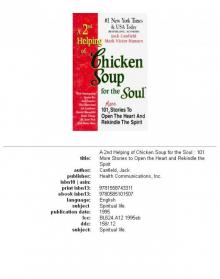 A 2nd Helping of Chicken Soup for the Soul
A 2nd Helping of Chicken Soup for the Soul Chicken Soup for the Nurse's Soul
Chicken Soup for the Nurse's Soul Chicken Soup for the Breast Cancer Survivor's Soul
Chicken Soup for the Breast Cancer Survivor's Soul Chicken Soup for the Pet Lover's Soul
Chicken Soup for the Pet Lover's Soul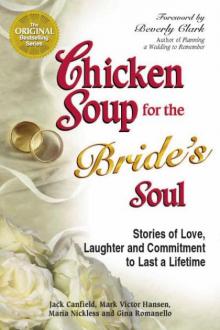 Chicken Soup for the Bride's Soul
Chicken Soup for the Bride's Soul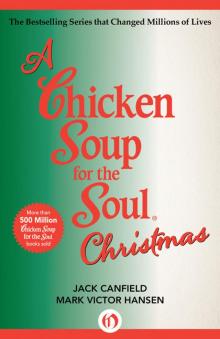 A Chicken Soup for the Soul Christmas
A Chicken Soup for the Soul Christmas Chicken Soup for the Soul of America
Chicken Soup for the Soul of America Chicken Soup for the Teenage Soul on Tough Stuff
Chicken Soup for the Teenage Soul on Tough Stuff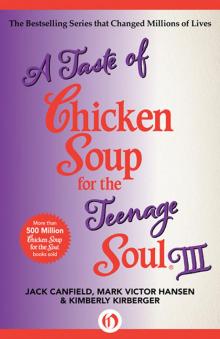 A Taste of Chicken Soup for the Teenage Soul III
A Taste of Chicken Soup for the Teenage Soul III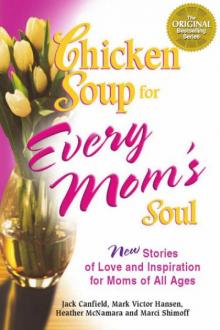 Chicken Soup for Every Mom's Soul
Chicken Soup for Every Mom's Soul Chicken Soup for the Dog Lover's Soul
Chicken Soup for the Dog Lover's Soul A Second Chicken Soup for the Woman's Soul
A Second Chicken Soup for the Woman's Soul Chicken Soup for the Soul the Book of Christmas Virtues
Chicken Soup for the Soul the Book of Christmas Virtues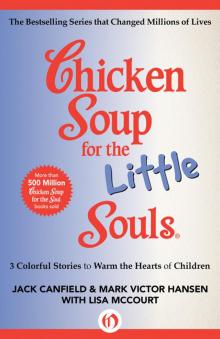 Chicken Soup for the Little Souls: 3 Colorful Stories to Warm the Hearts of Children
Chicken Soup for the Little Souls: 3 Colorful Stories to Warm the Hearts of Children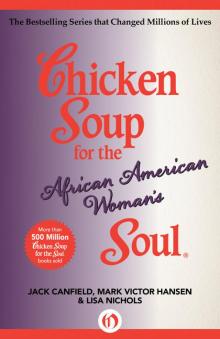 Chicken Soup for the African American Woman's Soul
Chicken Soup for the African American Woman's Soul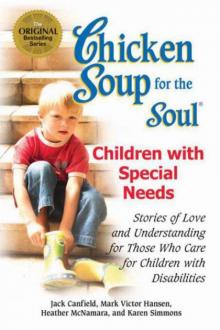 Chicken Soup for the Soul
Chicken Soup for the Soul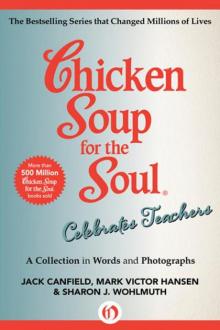 Chicken Soup for the Soul Celebrates Teachers
Chicken Soup for the Soul Celebrates Teachers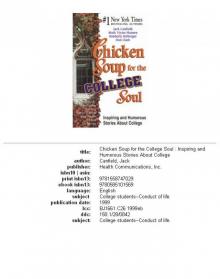 Chicken Soup for the College Soul
Chicken Soup for the College Soul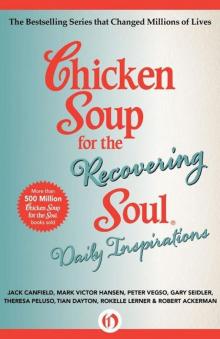 Chicken Soup for the Recovering Soul Daily Inspirations
Chicken Soup for the Recovering Soul Daily Inspirations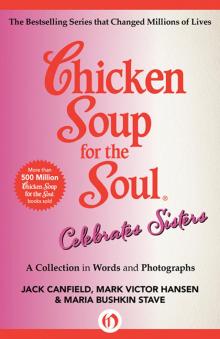 Chicken Soup for the Soul Celebrates Sisters
Chicken Soup for the Soul Celebrates Sisters Chicken Soup for the Dieter's Soul
Chicken Soup for the Dieter's Soul Chicken Soup for the Soul at Work 101 Stories of Courage
Chicken Soup for the Soul at Work 101 Stories of Courage Chicken Soup for the Beach Lover's Soul
Chicken Soup for the Beach Lover's Soul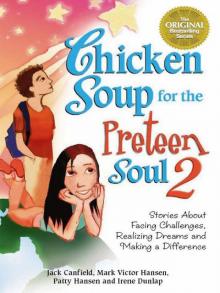 Stories About Facing Challenges, Realizing Dreams and Making a Difference
Stories About Facing Challenges, Realizing Dreams and Making a Difference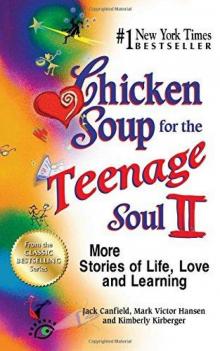 Chicken Soup for the Teenage Soul II
Chicken Soup for the Teenage Soul II Chicken Soup for the Girl's Soul
Chicken Soup for the Girl's Soul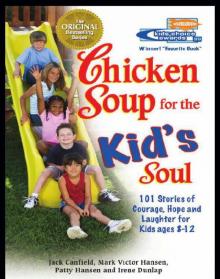 Chicken Soup for the Kid's Soul: 101 Stories of Courage, Hope and Laughter
Chicken Soup for the Kid's Soul: 101 Stories of Courage, Hope and Laughter Chicken Soup for the Woman's Soul
Chicken Soup for the Woman's Soul Chicken Soup for the Cancer Survivor's Soul
Chicken Soup for the Cancer Survivor's Soul Chicken Soup for the Canadian Soul
Chicken Soup for the Canadian Soul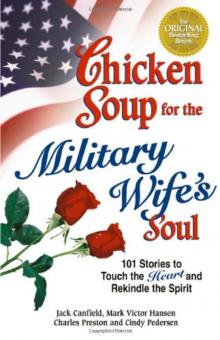 Chicken Soup for the Military Wife's Soul
Chicken Soup for the Military Wife's Soul A 4th Course of Chicken Soup for the Soul
A 4th Course of Chicken Soup for the Soul Chicken Soup Unsinkable Soul
Chicken Soup Unsinkable Soul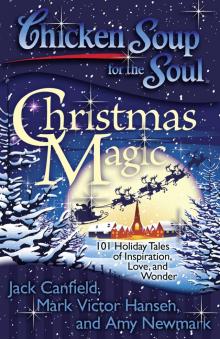 Chicken Soup for the Soul: Christmas Magic
Chicken Soup for the Soul: Christmas Magic Chicken Soup for the Grandma's Soul
Chicken Soup for the Grandma's Soul Chicken Soup for the Soul: All Your Favorite Original Stories
Chicken Soup for the Soul: All Your Favorite Original Stories Chicken Soup for the Expectant Mother's Soul
Chicken Soup for the Expectant Mother's Soul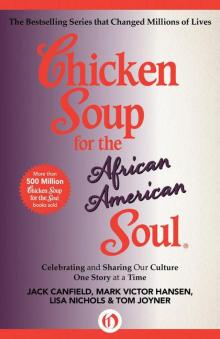 Chicken Soup for the African American Soul
Chicken Soup for the African American Soul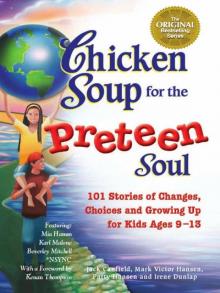 101 Stories of Changes, Choices and Growing Up for Kids Ages 9-13
101 Stories of Changes, Choices and Growing Up for Kids Ages 9-13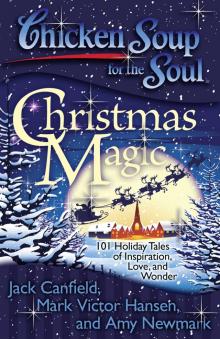 Christmas Magic
Christmas Magic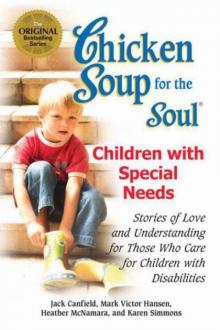 Chicken Soup for the Soul: Children with Special Needs
Chicken Soup for the Soul: Children with Special Needs Chicken Soup for the Soul: Country Music: The Inspirational Stories behind 101 of Your Favorite Country Songs
Chicken Soup for the Soul: Country Music: The Inspirational Stories behind 101 of Your Favorite Country Songs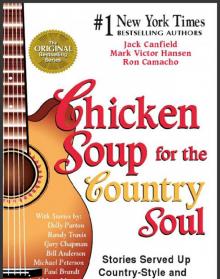 Chicken Soup for the Country Soul
Chicken Soup for the Country Soul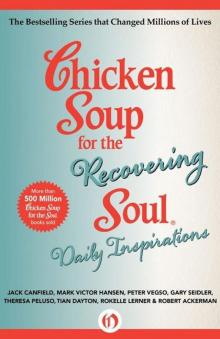 Chicken Soup for the Recovering Soul Daily Inspirations (Chicken Soup for the Soul)
Chicken Soup for the Recovering Soul Daily Inspirations (Chicken Soup for the Soul)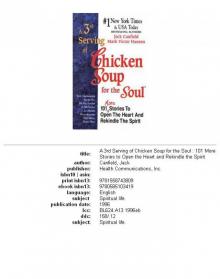 A 3rd Serving of Chicken Soup for the Soul
A 3rd Serving of Chicken Soup for the Soul The Book of Christmas Virtues
The Book of Christmas Virtues Chicken Soup for the Soul at Work
Chicken Soup for the Soul at Work Chicken Soup for the Soul 20th Anniversary Edition
Chicken Soup for the Soul 20th Anniversary Edition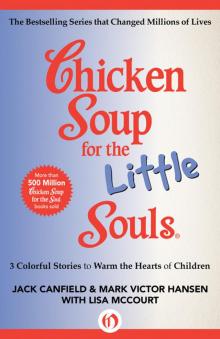 Chicken Soup for the Little Souls
Chicken Soup for the Little Souls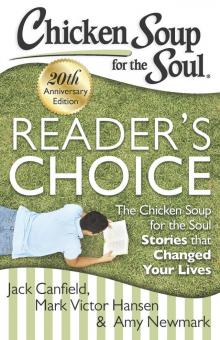 Chicken Soup for the Soul: Reader's Choice 20th Anniversary Edition
Chicken Soup for the Soul: Reader's Choice 20th Anniversary Edition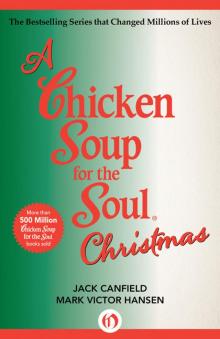 Chicken Soup for the Soul Christmas
Chicken Soup for the Soul Christmas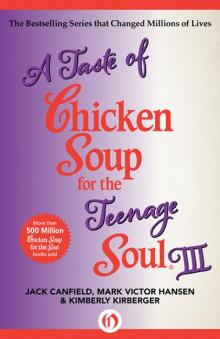 Taste of Chicken Soup for the Teenage Soul III
Taste of Chicken Soup for the Teenage Soul III Chicken Soup for the Unsinkable Soul
Chicken Soup for the Unsinkable Soul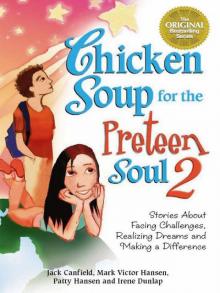 Chicken Soup for the Preteen Soul II
Chicken Soup for the Preteen Soul II